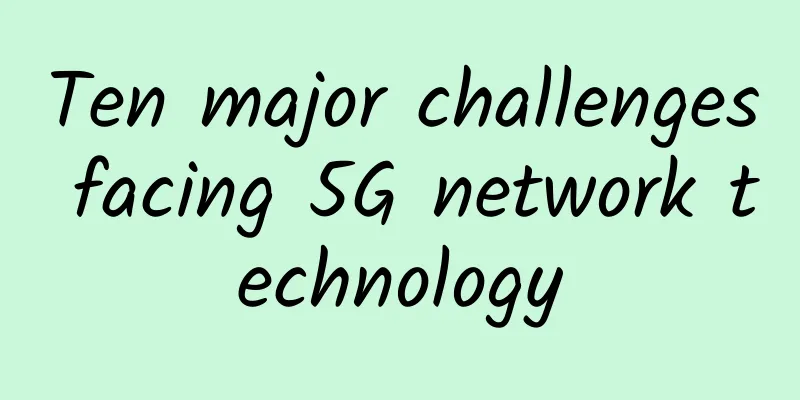Ten major challenges facing 5G network technology

|
On January 9, 2020, China released the first batch of 5G standards, which accelerated the development of 5G-related industries. Looking to the future, Wu Hequan, an academician of the Chinese Academy of Engineering, believes that 5G is a revolution in network technology, introducing many network technologies that have not been used on a large scale in the past. From the perspective of 5G network technology architecture, the underlying traditional transmission bearer network SDH is changing; the third layer network is the IP layer, which was not connection-oriented before. Because 5G needs to consider the introduction of IPv6, it may use the intelligent switching of the second layer of the network; the second layer will not copy the previous network, but will use Ethernet-based TSN (time-sensitive network). New technologies such as network slicing, SDN (software-defined network), NFV (network function virtualization), amorphous cells, and user-centric networks will all be applied in 5G networks. Wu Hequan said: "The 5G standard is ideal, but the network reality is very bleak." He summarized the technical challenges brought about by the introduction of new technologies into ten items. 1. Challenges of Software-Defined Networking First, software-defined networks bring challenges. Since the establishment of the Internet, IP has been basically grouped, but connectionless. Each IP packet is written independently, and the path it takes may be different. Although they all go from A to D, they actually work independently. Because the network was unstable in the early days of the Internet, it was transmitted in packets. Even if a packet was lost, only the packet needed to be retransmitted, and there was no need to retransmit most of it. However, this approach sacrificed efficiency. Implementing routing based on IPv6 in 5G will also bring challenges, because IPv6 addresses are not only used to define the location and identity of the terminal, but also define the route. The benefit of this is to ensure low latency and high reliability, which is what 5G hopes to achieve, but there are obviously challenges. SDN realizes the separation of transmission and control, and actually turns connectionless into connection-oriented. It uses the network operating system to centrally manage the network, calculates the end-to-end route for each service flow based on big data and artificial intelligence, and embeds the routing information into the IPv6 extension header of the original node and transmits it to each node along the original path. Intermediate nodes only need to forward without selecting a route, ensuring low-latency forwarding. Although it is now expected that all service flows and all nodes can be optimized in real time through SDN, multi-objective optimization of large-scale networks and low-latency responses is a difficult problem. The calculated routing services are constantly changing, network resources are constantly changing, and the calculated routes may conflict and not converge. One method is to divide SDN into several levels and select SDN by region. Then, there is no problem in the local area, but the cross-regional routing requires the exchange of service flow and network resource data between SDNs, which increases the complexity of implementation. Another method is to only forward some service flows according to the connection of each surface, and other service flows have to return to the connectionless mode for processing. 2. Challenges of Network Function Virtualization Traditional switches are dedicated hardware and software, and traditional routers are also dedicated hardware and software. The equipment cannot be changed, and their working levels in the network architecture are also fixed. In order to achieve business flexibility, 5G requires network equipment to have different capabilities. The direction of NFV (network function virtualization) is universal hardware and definable software, which is of course ideal. Although NFV has improved network utilization efficiency, it has reduced latency. The premise of using NFV is to accurately obtain global business flows and network resource data. It is difficult to avoid conflicts in network resources when SDN and NFV are operated simultaneously. The trend of "white box" network equipment also has problems. Compared with dedicated equipment, the latency of white box equipment may be greater. Moreover, it is absolutely impossible for the network to become "white box" all in one day. The existing stock cannot be "white boxed". If the existing stock and "white box" increment coexist in the same network, can the effect of NFV be reflected? This is also a challenge. We need to consider whether we really want to turn the entire network into NFV. 3. Challenges of Network Slicing Different network slices can be formed according to business logic requirements, which are divided into at least three categories: enhanced mobile broadband, high reliability and low latency, and large connections. It is a very good idea to form a VPN (virtual private network) for each business organization through network slicing management, but it is actually difficult. For example, in Beijing's traffic, there is a dedicated bus lane for buses during the morning and evening peaks. If 5G is built, all businesses will use dedicated lanes. Buses have bus lanes, buses have bus lanes, and cars have car lanes. Can this be done for tricycles and motorcycles? It is difficult to have a full-link VPN now. 5G wants to open this network slice to large customers, allowing them to discover, select, generate and manage VPNs, and provide large customers with the right to adjust dynamically in real time on demand, but VPN cannot be implemented across operators. The preferred approach is to only provide network slices for services that have relatively strict requirements on latency, packet loss rate and reliability. Compared with the existing 4G network VPN, 5G VPN can be provided in real time. In addition, a model centered on user value and billing by service quality should be considered, rather than a billing model based on traffic. 4. SBA Challenges SBA (Service Based Architecture) can make 5G business open. In the past, the mobile network protocol was dedicated and closed. Now, in order to adapt to future business needs, the protocol is Internet-based. In this way, many existing Internet applications can be directly transplanted to 5G. This is a good thing, but it brings a problem. First of all, the idea of business openness like SBA existed in the telecommunications network 30 years ago. Now the network traffic is larger, and the problem is bigger. The network of operators used to be closed, and now we rarely hear about network security incidents where the network of operators was paralyzed by hacker Trojans. Why? Because it is closed and not universal, especially the network protocol of operators is dedicated. SBA makes the network and business open, and the protocol is universal. It can be said that 5G has greater network information security risks than 4G. This is not to say that 5G is unsafe, but for the flexibility of 5G services we have to bear the risks that this insecurity brings, and this process will not be smooth. 5. Challenges of edge computing 5G edge computing is designed to sink computing power to the edge, which is responsible for processing time-sensitive data and filtering it before sending it to the central cloud. According to IDC's forecast, more than 50% of data will be processed at the edge layer in the future, and the cost of a two-level cloud is only 39% of a single-level cloud, which saves money. This is of course a good thing. Some capabilities of cloud computing are decentralized, including storage and content distribution capabilities, which can adapt to low latency and fast processing. However, to what extent is the granularity of the edge cloud? To what extent is it decentralized? Is it decentralized to each DU distribution unit, to the CU centralized unit, or to a higher level? How to choose the density of edge computing is a challenge. Edge computing is not a fixed edge cloud. For example, a car may be connected to one base station at one time and another base station at another time. If edge computing is implemented in a base station, then the edge computing point must be constantly changing, which generates communication between edge computing. Whether this communication is through the central cloud or between edge clouds is not well studied. In addition, communication between edge clouds requires a lot of network overhead, which will introduce latency. 6. Challenges of Precise Synchronization Whether it is NFV or SDN, the data reported by all nodes should be the same when collected at the same time. If the time synchronization is not accurate, the data obtained will be inaccurate. At this time, the decision made based on inaccurate data will be even worse. In the past, telecom networks used IEEE1588 for time synchronization. Can 1588 meet the synchronization requirements of 5G? According to the current method, time synchronization is not accurate because the calculated time deviation is constantly changing. In the future, 5G may have new requirements for time synchronization. 7. Challenges of operational support The 5G operation support system includes not only the fault management, configuration management, alarm management, and performance management of traditional networks, but also the management of NFV, when the network element is used as a router, switch, and when it is used as a cross-link. As the business flow changes, at the same time, the network element is a router for one business flow and a switch for another business flow. This is changing. Moreover, network slicing is also changing. When services come, they need slicing. When services leave, they need to be revoked. This is dynamic. If network management is still done manually at the network level as before, it is simply impossible. Now it must be managed by signaling, with a very complex orchestrator to design network elements and service components. If the entire network is an OSS, it will be very complex, and how can such a large network processing capacity and processing latency meet the requirements? OSS can be managed hierarchically, but cross-region and cross-OSS negotiation is also a big challenge. 8. Challenges of Internet of Vehicles The Internet of Vehicles is considered an important application scenario for 5G. 5G has considered low latency measures in both the access network and the core network, but the things for personal communication are very different from those for the Internet of Vehicles. On average, personal communication on the public network has to go through more than ten nodes, while the communication of the Internet of Vehicles is just one or two hops. In a multi-hop environment, NFV, network slicing, and SRv6, which are outstanding in controlling latency, do not have a clear advantage in the Internet of Vehicles scenario. Traditional personal communication is point-to-point in access, but now the Internet of Vehicles in the V2V scenario is point-to-multipoint, multipoint-to-multipoint, or even broadcast, which will increase the difficulty of frequency arrangement and make it difficult to adopt. If D2D connection is not possible, V2N2V will be used, and the latency will increase slightly. The information sent by the public is initiated by the caller and known to the called party; however, the information sent by each car in the Internet of Vehicles is not controlled by the car owner. The effect of 5G network technology that supports enhanced mobile broadband, high reliability, low latency, wide coverage and large connections in the Internet of Vehicles environment is still worth studying. Although 5G is more suitable for the Internet of Vehicles than 4G, these technologies have not really played a role in the Internet of Vehicles, so we have to wait and see what the standards for the Internet of Vehicles will be in March next year. China now has 13 direct connection points, which are responsible for connecting 30 provinces across the country. Some provinces need to connect outside the province, such as China Telecom, China Unicom, and China Mobile Internet in Guizhou, which can only communicate through the Chongqing direct connection point. If the Internet of Vehicles still uses this direct connection point, the city will be in chaos. The Internet of Vehicles requires that the direct connection point must be in the city. 9. Challenges of 5G Massive Connectivity 5G supports 1 million IoT devices per square kilometer. How can each IoT device be connected? If all terminals need to be authenticated, one by one will not work. This is a difficult problem. Large connections cannot be slow. Some sensors can be slower, but the Internet of Vehicles must be fast. mMTC requires each terminal to have a security algorithm and protocol, but the security algorithm must be simple, otherwise it will increase latency. It is difficult to be both safe and simple. The terminal equipped with uRLLC must be highly reliable. In the past, credit cards were used. Now, how should such a large number of IoT terminals be managed? With the advent of 5G, there are new challenges in IoT authentication, security, identification, and identity. 10. Challenges of 5G Enterprise Private Network The network of operators is mainly designed for consumers. The TDD mode adopted by 5G has both uplink and downlink data on the same frequency band. Consumer applications generally have more downlink and less upload, which is asymmetric. The uplink and downlink frequencies are used 70% and 30% of each other. For industrial applications, most industrial sensors upload more messages, send videos uplink, and receive network commands downlink, which is a reverse 30% and 70% split. If there are two different configurations on the operator's network, it will cause interference because different carrier frequencies must be selected. For industrial applications, enterprises need to invest in private networks to achieve flexible configuration and network security, which is good. The problem is that the telecommunications management department needs to issue dedicated frequencies for it. Now Europe has reserved 76MHZ for 5G private networks, Germany has allocated 100MHZ, and Shanghai Commercial Aircraft Corporation and other companies have also proposed to build 5G private networks. Most enterprises may seek the operator's public network to solve the problem of asymmetric TDD upper and lower configurations, which is an issue that needs to be considered. Wu Hequan said that 5G is the embodiment of new network technologies. In addition to the ten major network challenges mentioned above, its development also faces challenges in spectrum resources, site selection, and network security. The integration of 5G with the Internet of Things, cloud computing, and artificial intelligence has given rise to new business forms, but it has also brought new risks in the application of social privacy protection laws. Therefore, in the development of 5G, it is necessary to gradually improve technology, management, and the legal system to promote 5G applications. |
<<: Seven key developments for SD-branch in 2020
>>: How to deal with the impact of digital transformation on the network?
Recommend
A Preliminary Study on Software Defined Network (SDN)
【51CTO.com Quick Translation】Before 2008, the ent...
How to choose the best flash storage for your data center?
The all-flash data center is a futuristic concept...
IDC predicts that the domestic Wi-Fi 6 market will be close to US$200 million in 2020
Recently, IDC released the "China WLAN Marke...
In addition to base stations, what else should major cities pay attention to in 5G construction?
It has been a year since 5G was officially put in...
These core Internet protocols are gradually changing
The Internet we are familiar with used to mainly ...
Blockchain technology will change the world in these four ways
As the underlying technology of Bitcoin, blockcha...
spinservers: 256GB memory San Jose server from $99/month, Dallas server from $89/month
spinservers recently released several special-pri...
Interview: ZooKeeper 23 questions, see if you can answer them
1. What is ZooKeeper? ZooKeeper is a distributed,...
Ruijie's all-scenario cloud desktop leads the new trend of Internet medical development
At present, affected by the epidemic, Internet me...
One year has passed since China's 5G license issuance, and these opportunities and challenges are becoming clearer
With the extensive publicity of the media and the...
Get AlertManager working in 5 minutes and access 10+ notification channels including SMS, voice, etc.
SLS Alarm Management As a member of the Prometheu...
ProfitServer has opened 4 new data centers in Hong Kong, starting from $5.77 per month for 100M unlimited traffic
ProfitServer sent a new email a few days ago, say...
In 2020, China's network market: routers benefit from new infrastructure, and the Internet industry increases investment in switches
Recently, IDC released the "2020 Network Mar...
ZJI: Hong Kong Confederation Server 30% off, 560 yuan/month-2*E5-2630L/32G memory/480G SSD/30Mbps bandwidth
This month, ZJI offers a 30% discount code for Ho...
Predictions for IT development after COVID-19
Gartner and IDC predict that global IT spending w...









